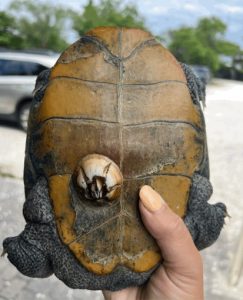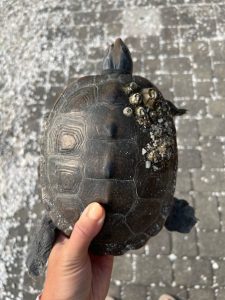by Brian Williamson, Research Scientist
 Each year at The Wetlands Institute we incorporate new projects designed to investigate emerging and long-standing questions about the organisms we study. While we have been working with terrapins for decades, much remains to be learned about these important members of the saltmarsh community and how the changing marsh affects this species. In 2024, we had the opportunity to investigate a potential trend we noticed over the past several years – a possible increase in the number of terrapins with barnacles growing on their shells. While many think of barnacles as growing mainly on rocks and other inanimate objects, they sometimes colonize marine animals as well, attaching themselves to sea turtles, terrapins, horseshoe crabs, and the skin of whales. Though this may seem harmless, studies have shown that barnacles can be harmful to shell growth and potentially cause other health issues.
Each year at The Wetlands Institute we incorporate new projects designed to investigate emerging and long-standing questions about the organisms we study. While we have been working with terrapins for decades, much remains to be learned about these important members of the saltmarsh community and how the changing marsh affects this species. In 2024, we had the opportunity to investigate a potential trend we noticed over the past several years – a possible increase in the number of terrapins with barnacles growing on their shells. While many think of barnacles as growing mainly on rocks and other inanimate objects, they sometimes colonize marine animals as well, attaching themselves to sea turtles, terrapins, horseshoe crabs, and the skin of whales. Though this may seem harmless, studies have shown that barnacles can be harmful to shell growth and potentially cause other health issues.
Working alongside our interns, we began counting barnacles present on the shells of nesting terrapins, and this summer Coastal Conservation Research Program intern Darby Brant helped us to compare these results to counts from previous years using our database of photographs of terrapins. Though more work is required to fully understand this trend, we found that barnacle infestations are significantly more common now than in years past. Many questions remain about barnacle infestation of terrapins, including their long-term impacts, which species of barnacles are present, and what factors may be driving the increase we have observed.
 This is a complex and relatively unstudied topic that bridges scientific disciplines, and we hope to collaborate with scientists throughout the region who have expertise on barnacles as well as other terrapin researchers to help us unearth answers to these questions. We plan to continue to monitor trends in barnacle infestation going forward to help us understand the possible impacts it may have on our terrapin population.
This is a complex and relatively unstudied topic that bridges scientific disciplines, and we hope to collaborate with scientists throughout the region who have expertise on barnacles as well as other terrapin researchers to help us unearth answers to these questions. We plan to continue to monitor trends in barnacle infestation going forward to help us understand the possible impacts it may have on our terrapin population.
